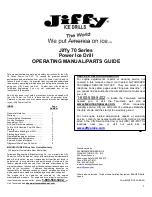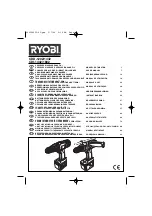
20
21
SPECIFICATIONS
Tool
Capacities
Cat. No.
Volts
AC
Watts
No Load
RPM
No Load
BPM
Drill Only
Hammer-Drill
Twist Drill
Bit (Wood)
Twist Drill
Bit (Steel)
Carbide Tipped
Percussion Bit
(concrete)
5374-59
5374-59A
5374-59B
220-240V 50-60Hz
220-240V 50-60Hz
127V 50-60Hz
680
680
680
0 - 3 000
0 - 3 000
0 - 3 000
48 000
48 000
48 000
32 mm
(
1-1/4'')
13 mm (1/2")
16 mm (5/8")
ASSEMBLY
Installing Bits into Keyed Chucks
Be sure that the shank of the bit and the chuck
jaws are clean. Dirt particles may cause the bit
to line up improperly. Do not use bits larger than
the maximum recommended capacity of the drill
because gear damage or motor overloading may
result. For best performance, be sure that the bits
are properly sharpened before use.
1. Unplug the tool.
2. Open the chuck jaws
wide enough to insert a
bit. Allow the bit to strike
the bottom of the chuck.
Center the bit in the
chuck jaws and tighten
the jaws by hand to
align the bit.
3. Place the chuck key
into each of the three
holes in the chuck, turning it clockwise to tighten
the chuck securely.
NOTE:
Never use a wrench or means other than
a chuck key to tighten or loosen the chuck.
4. To remove the bit, insert the chuck key into one
of the holes in the chuck and turn it counterclock-
wise.
Loosen
Tighten
OPERATION
Selecting Action
MILWAUKEE
Hammer-Drills have two settings:
drilling and hammer-drilling.
1. For
drilling
, slide the hammer-
drill lever to display the drill
symbol .
2. For
hammer-drilling
, slide the
hammer-drill lever to display the
hammer symbol .
NOTE:
To engage the ham-
mering mechanism, maintain
pressure on the bit. When pressure on the bit is
released, hammering action will stop.
Using Forward/Reverse Lever
The forward/reverse lever can only be adjusted
when the trigger is not pressed. Always allow the
motor to come to a complete stop before using the
forward/reverse lever. When hammer-drilling, use
the tool in forward rotation (clockwise) only.
1. For
forward
(clockwise) rotation, slide the for-
ward/reverse lever display the forward symbol
.
2. For
reverse
(counterclockwise) rotation, slide
the forward/reverse lever display the reverse
symbol .
Starting, Stopping & Controlling Speed
1. To
start
the tool, pull trigger.
2. To
stop
the tool, release trigger.
3. To
vary
the speed, increase or decrease pres-
sure to trigger. The further the trigger is pulled,
the greater the speed.
Locking Trigger
The lock button holds the trigger in the ON position
for continuous full speed use.
1. To
lock
the trigger, hold in the lock button while
pulling the trigger. Release the trigger.
2. To
unlock
the trigger, pull the trigger and release.
The lock button will pop out.
Operating
Position the tool, grasp the handles fi rmly and pull
the trigger. Always hold the tool securely using
both handles and maintain control. This tool has
been designed to achieve top performance with
only moderate pressure. Let the tool do the work.
If the speed begins to drop off when drilling deep
holes, pull the bit partially out of the hole while the
tool is running to help clear dust. Do not use wa-
ter to settle the dust since it will clog the bit fl utes
and tend to make the bit bind in the hole. If the bit
should bind, a built-in, non-adjustable slip clutch
activates. If this occurs, stop the tool, free the bit
and begin again.
WARNING
To reduce the risk of injury,
always use a side handle when using this tool.
Always brace or hold securely.
WARNING
To reduce the risk of injury,
always unplug tool before attaching or remov-
ing accessories or making adjustments. Use
only specifi cally recommended accessories.
Others may be hazardous.
Adjusting the Side Handle Position and setting
the Depth Gauge
1. Loosen the side handle by unscrewing the side
handle grip until the side handle rotates freely.
2. Rotate the side handle to the desired position.
3. Slide the depth gauge rod to the desired position.
The drilling depth is the distance between the tip
of the bit and the tip of the rod.
4. Tighten the side handle grip securely.
WARNING
To reduce the risk of injury
do not grasp the bit while the chuck is rotat-
ing or while the bit is falling from the chuck.
WARNING
To prevent personal injury,
always remove the chuck key from the chuck
after each use.
WARNING
To reduce the risk of injury,
keep hands and cord away from the bit and
all moving parts.
WARNING
To reduce the risk of injury,
wear safety goggles or glasses with side
shields.
WARNING
To reduce the risk of injury,
always unplug tool before attaching or remov-
ing accessories or making adjustments. Use
only specifi cally recommended accessories.
Others may be hazardous.































